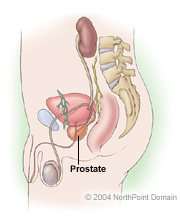PSA (Prostate Specific Antigen)

Basic Facts
- A prostate specific antigen (PSA) test measures the amount of PSA in the blood.
- PSA levels are often higher when a man has cancer or another prostate disorder, such as inflammation or an enlarged prostate.
- Only one-fifth to one-third of men with elevated PSA levels are diagnosed with prostate cancer.
- Men should have this screening starting at 50; high-risk groups should begin at age 40, specifically men who have a brother, father, or son with prostate cancer.
A prostate specific antigen (PSA) test measures and analyzes the level of PSA in a blood sample. It is normal for PSA levels to increase as a man ages and his prostate gland enlarges. Physicians only become concerned when PSA levels increase above what is considered a normal level. A man’s PSA level is considered slightly elevated if it is between 4 and 10 (nanograms per milliliter) ng/mL, moderately elevated if it is between 10 and 20 ng/mL, and highly elevated when more than 20 ng/mL. When accurate PSA readings are combined with a digital rectal examination (DRE), a manual examination of the prostate to feel for abnormalities that is performed by a physician, the two tests can detect nearly 90 percent of prostate cancer.Men should have an annual PSA test according to the following guidelines:
- At age 40 for black men or if a man has a father or brother who had prostate cancer; or
- At age 50 for all other men.
RISK FACTORS
Men are at risk of having an inaccurate reading if they are taking finasteride (Proscar).
Other factors that can cause an inaccurate PSA reading include:
- Recent urological procedures;
- Recent DRE; and
- Recent ejaculation.
PRE-TEST GUIDELINES
The PSA test, much like a standard blood test, requires no patient preparation. However, because ejaculation may reduce PSA levels, physicians recommend patients avoid sexual activity 48 hours before giving blood for the PSA test.
WHAT TO EXPECT
A technician, nurse, or physician will wrap a tourniquet or blood pressure cuff around the upper arm and apply alcohol to the skin over the vein that will be used to draw the blood. He or she then punctures both the skin and vein in one stroke using a sterile, disposable needle, which in some people causes pain or the sensation of a prick. Blood will be drawn into the syringe and the needle withdrawn from the arm. The physician sends the blood to a laboratory for analysis.
POST-TEST GUIDELINES
Following a PSA test, patients can resume normal activities.
Copyright © 2017 NorthPoint Domain, Inc. All rights reserved.
This material cannot be reproduced in digital or printed form without the express consent of NorthPoint Domain, Inc. Unauthorized copying or distribution of NorthPoint Domain’s Content is an infringement of the copyright holder’s rights.

